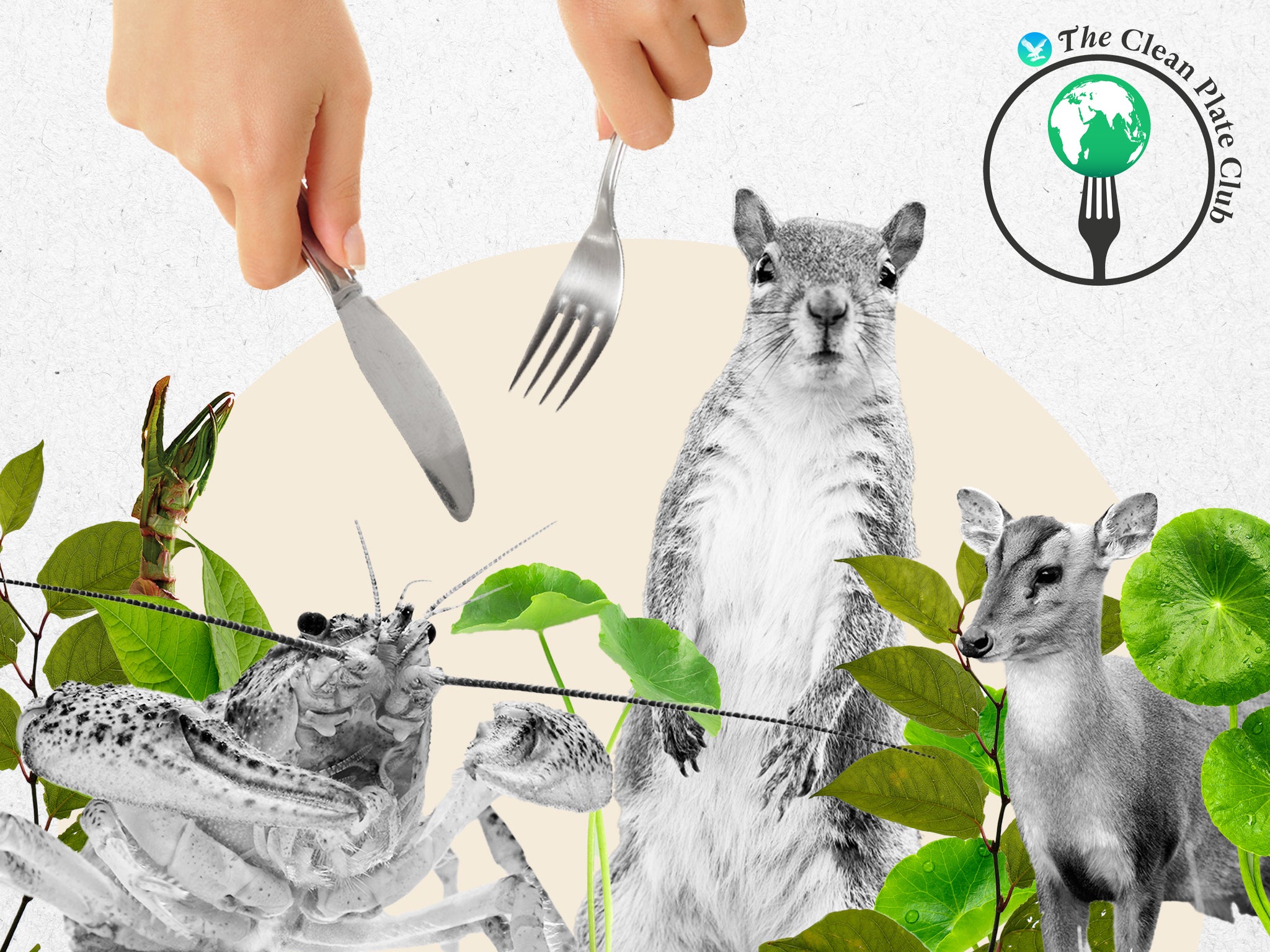From Japanese knotweed to grey squirrel: How one chef is plating up invasive species
Japanese knotweed, grey squirrels, and American signal crayfish are just some of the invasive species endangering native biodiversity in the UK. But what if we ate them? Kate Ng piques her appetite for the pests that plague Britain


Utter the words “Japanese knotweed” to a homeowner and all the blood is likely to drain from their face. They may break into a cold sweat, eyes darting around frantically as they grab your shoulders and shake you, shouting: “WHERE??”
The notorious weed was first introduced into the UK by German-British botanist Philipp von Siebold in the 19th century as an ornamental plant, for its large, heart-shaped green leaves and hollow stems, with clusters of small white flowers that bloom in late summer. Its import proved to be disastrous. Without the checks and balances of its native land that kept it under control, the knotweed thrived in the UK, growing stronger, larger and more fiercely.
The fast-growing plant can wreak havoc on a home, growing Jumanji-style under fences and between cracks in walls and patios. Even a small thumb-sized piece of its rhizomes, underground stems that grow horizontally, could sprout a whole new plant that can exert enough pressure on concrete to gradually prize it apart. The weed is so problematic that it can devalue a property by as much as 15 per cent or, in some rare cases, completely. Removing it is no mean feat either, and can cost as much as £10,000.
Its fast-growing nature also affects ecosystems by crowding out native vegetation, which limits plant and animal species diversity. Today, there is barely a corner of the country that is untouched by Japanese knotweed, save for the Highlands.
So fearsome is Japanese knotweed that seeing its name on a restaurant menu may send chills down the spines of anyone who owns or deals with property in the UK. But I’m about to tuck into two spears of the stuff in zero waste restaurant Silo, Hackney Wick – perhaps the only place in London where it may be conceivable to do so.
The shoots of Japanese knotweed look like sinister asparagus. They have the same thick stem that tapers into the shape of a spear, but instead of the rubber-soft clusters we know and love, the tips of Japanese knotweed shoots appear distinctly spiky. The reddish-green hue doesn’t do it any favours either.
But when grilled and served alongside a salad of brassica and a cured egg yolk, Japanese knotweed takes on a more unsuspecting appearance. It is tender and tart, often compared to rhubarb in flavour but with more versatility, suiting both savoury and sweet dishes.

Chef Doug McMaster, who founded Silo a decade ago this month, wants to show people a different side to Japanese knotweed and other invasive species such as grey squirrel, American signal crayfish, Japanese wireweed and pennywort.
All invasive species that outcompete native animals and plants have a disastrous effect on the ecosystem. Grey squirrels breed quickly and bully their native red counterparts out of their territory, as well as spread a squirrelpox virus that is fatal to the latter, but not the former. American signal crayfish proliferate in the UK’s river systems, eradicating native plants, small invertebrates and fish wherever they go.
What I’m trying to propose with this event is that we find a greater balance and harmony within the ecosystem
There are established methods to control these species. For pests, control strategies often involve trapping or hunting, contraception to stop them breeding and natural predation. McMaster takes a different approach: “If you can’t beat ’em, eat ’em.”
“It’s a radical act of sustainability, that’s how I see it,” he tells The Independent. “Not only are we eating the problem, but we are also mitigating the energy and resources that would have been wasted if we let it go to waste.”
He points towards what he calls an “atrophic cascade” of environmental damage caused by invasive species as the main reason Britons should consider eating them.

“They are reproducing and destroying environments that other species can’t live without, which causes entire ecosystems to crash and it’s a type of devastation that we often don’t see,” he says.
“What I’m trying to propose with this event is that we find a greater balance and harmony within the ecosystem. That’s extreme sustainability and should be a positive thing no matter which way you look at it.”
The chef, who was named Great Britain’s best young chef in 2009, has dreamed up a dizzying array of ways to serve up the pests, such as a grey squirrel kofte, with black ketchup and chicken neck garum. The meat is tender and juicy, almost porky in flavour. The rodent is also used to make a rich broth, balanced with tangy pickled knotweed to wake up the tongue.
A lion’s mane mushroom swimming in signal crayfish bisque almost has me licking the plate, while a creamy sauce made from hogweed that accompanies a cut of velvety venison is a revelation. And who would’ve known that Japanese knotweed compote would go so well with panela ice cream? One can only expect the unexpected with McMaster’s invasive dinner series.

Eating invasive species seems like a no-brainer. After all, eating invasive species is not a new concept in many other parts of the world. Even in the UK, it’s not so uncommon to consume grey squirrel in some parts of the countryside.
In Cumbria, where former Masterchef contestant Kevin Tickle grew up, eating grey squirrels was a relatively normal part of life. He used to run Forest Side Restaurant in Ambleside, where he served customers The Little Critter Fritter, a croquette that combined pork, rabbit and grey squirrel.
“Personally, I do a lot of grey squirrel control because you get a lot of them up here,” he says. This is a gross understatement – grey squirrels are driving their native counterparts in the area to extinction, so much so that the red rodents are afforded the highest level of protection under the Wildlife and Countryside Act.
“It’s never occurred to me that it might be unusual to eat invasive species, but I think it is important for city people to be better educated on their impact. It might be more commonplace to have squirrel on the table at some point in the future.”
Eating it would be like bringing a dustpan and brush to the aftermath of an earthquake... The ship has already sailed
But could eating invasive species really help reduce their population numbers, and if so, why aren’t we doing it?
The answer isn’t so simple. Kay Pemberton, an expert on Japanese knotweed, tells The Independent that the plant is largely spread “through ignorance or illegal distribution”. This is due to people not realising they have Japanese knotweed in their soil, digging it up and dispersing it elsewhere, or some who purposefully get rid of contaminated soil by fly-tipping or hiding it in skips.
She thinks that while the idea of consuming invasive species such as Japanese knotweed is interesting, it’s unlikely to become a widespread practice and really depends on which species you’re eating.
In the case of Japanese knotweed, farmers “wouldn’t go near the stuff” because of how easily it can run riot, and an ordinary person would need a waste carrier licence in order to forage for it, because the plant is classed as “controlled waste”.

“I think that eating it would be like bringing a dustpan and brush to the aftermath of an earthquake,” Pemberton says. “The ship has already sailed; it won’t help to control or reduce the population. I truly believe that the only way to control it in a considered, appropriate manner, is herbicide treatment.
“Even if you eat it, the rhizomes will still remain. You can cut a shoot off, but the knotweed will keep growing more shoots; it won’t stop it from living. It could only be a food source for three to four weeks out of a year, as it becomes unpalatable beyond the early growing stages.”
There is also the risk that putting invasive species on menus could downplay how dangerous they are for the native environment. Professor Helen Roy, an ecologist who specialises in the dynamics of invasive species and their effects on biodiversity and ecosystems, says that the environmental impact of consuming such species would be minimal.

“I think there would be concerns that this could somehow create a market for these invasive non-native species and so send confusing messages about the huge threat that is posed by the environmental issue of biological invasions,” she tells The Independent.
“Of course people all around the world are living alongside invasive alien species and in some cases eating them but it would be far preferable to reduce the threat of biological invasions through enhanced biosecurity and prevention.”
However, McMaster is still hopeful that his dinner series will start further conversation about how consuming non-native species that pose a danger to British ecosystems could be viable – or at the very least, palatable. And people are interested.
“Tickets flew out. We sold out in two hours; the level of interest has been pretty overwhelming,” he says.
“The amount of energy going into these dinners is extraordinary: we’ve probably spent 200 hours on this labour of love. But Silo doesn’t exist to make a profit, we’re here to change the world. It sounds hyperbolic, but we genuinely care and want to make a difference and talk about these things that no one else will… We’re doing our best.”
This article was first published on 2 May 2022. Silo’s invasive species dinner series is no longer running.
Food waste is a huge global problem, with millions of tonnes of food being thrown away every year, accounting for eight to 10 per cent of greenhouse gas emissions worldwide. The Independent’s series, The Clean Plate Club, explores what can be done about food waste as the world continues to face up to the climate crisis.
Join our commenting forum
Join thought-provoking conversations, follow other Independent readers and see their replies
Comments